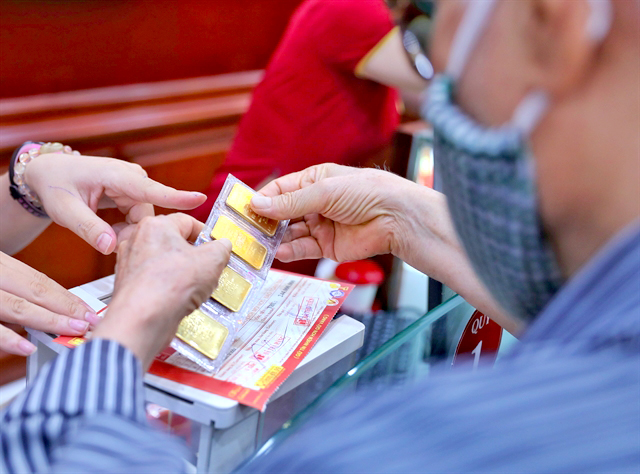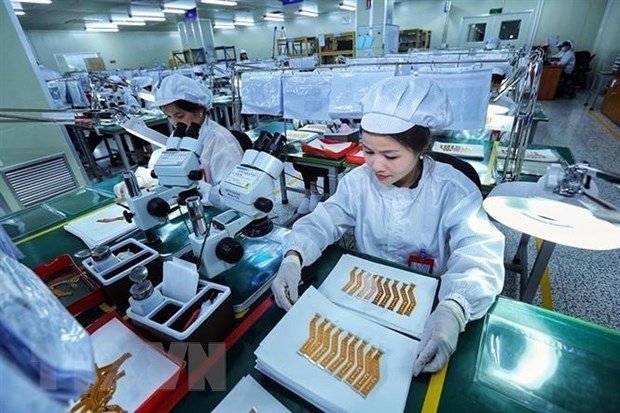 Business Beat
Business Beat

At the annual general meeting of Vietnam International Bank (VIB) in HCM City on March 28, shareholders approved a dividend of 26.5 per cent for 2019, including 5.5 per cent in cash and the rest in shares.
| ||
| VIB is one of only few banks that have decided to pay dividends in cash this year. — Photo cafef.vn |
Compiled by Thiên Lý
At the annual general meeting of Vietnam International Bank (VIB) in HCM City on March 28, shareholders approved a dividend of 26.5 per cent for 2019, including 5.5 per cent in cash and the rest in shares.
VIB is one of only few banks that have decided to pay dividends in cash this year.
Market observers said though most have yet to hold their annual general meeting this year, many banks have indicated they would pay dividends in shares and not cash.
Nam Á Commercial Joint Stock Bank (Nam A Bank) was one of the first lenders to hold its annual general meeting. On March 23, its shareholders approved many important business plans and targets for this year, one of which was to pay a 16 per cent dividend but only in shares.
In its consolidated financial statement sent to its shareholders ahead of this year’s annual general meeting, Vietnam Prosperity Joint Stock Commercial Bank (VPBank) also reported that the undistributed profits is VNĐ3.43 trillion (US$153.8 million) and would be retained to improve its financial capability.
Some State-owned banks like BIDV, Vietinbank and Vietcombank have also asked the Ministry of Finance to allow them to retain their profits and pay dividends in shares to increase their charter capital.
Most of the banks however had an excellent year in terms of earnings thanks to improved bad debt resolution and rising income from services.
Vietcombank’s 2018 pre-tax profit hit a record high of VNĐ18 trillion ($773 million), up by a whopping 63 per cent despite the central bank’s credit slowdown.
Vietcombank’s outstanding loans last year fell 14.9 per cent to more than VNĐ635 trillion, lower than the 17.2 per cent rate of 2017.
The impressive result was attributed to the bank’s success in controlling credit quality and increasing non-interest income.
Agribank reported an impressive pre-tax profit of VNĐ7.53 trillion aided by reduction of bad debts to 2.78 per cent and rising service revenues by 20 per cent.
TPBank doubled its 2017 pre-tax profit figure to VNĐ2.26 trillion.
VIB’s profit skyrocketed by 176 per cent to VNĐ1.72 trillion, following its great efforts to tackle bad debts. VIB was among the few banks that resolved all its bad debts at the VAMC and so did not have to make any provisioning.
Though credit growth was only 14 per cent in 2018, Sacombank’s profit still increased by 47 per cent to VNĐ2.2 trillion, 20 per cent higher than the target.
Analysts said many banks achieved very impressive profit growth in 2018, thus significantly improving their financial capability, but many of them, particularly those with capital of VNĐ3-5 trillion, are still under great pressure to increase their capital to meet the SBV’s Basel II requirements by 2020.
Most banks, which have a capital adequacy ratio of around 9 per cent, have to increase their capital to meet the requirements.
Many have tried hard to increase their capital but without much success.
Because of this, the lenders expected their huge profits in 2018 to help them partially increase their capital and therefore decided not to pay dividends in cash but in shares instead.
But banks' shareholders are unlikely to be unhappy at receiving dividends in shares this year as they used to be in the past.
Analysts said in previous years, most shareholders were unhappy with banks’ payment of dividends in shares despite knowing their reasons were legitimate.
But the prices of bank shares have increased significantly since last year and many investors would like to see them fall a bit on the back of bonus issues.
Market observers said leading the market in mid- March was the financial-banking sector, with their prices increasing by nearly 4 per cent since the beginning of the month.
Vietcombank had gained 5.1 per cent, and a total of 25 per cent in 2019, to climb to a six-month high of VNĐ66,000 on March 17.
The Bank for Investment and Development of Vietnam (BIDV) closed at VNĐ37,200 on March 15. It had gained nearly 35 per cent since the end of last October.
The market would advance further on the back of bank stocks, the analysts said. “At current price levels, bank stocks have room to advance.”
The strong increase in prices means many investors are readily agreeing to accept dividends in the form of shares so that prices come down to previous levels, they said.
Aviation industry boom has knock-on effect on catering
The results declared by companies involved in airline cartering show that the sector has become highly profitable in recent years.
Nội Bài Catering Service Joint Stock Company for instance generated turnover of VNĐ653 billion ($27.6 million) last year, with its the catering business contributing 78 per cent. On average, the company earned VNĐ1.4 billion per day from this segment.
Experts pointed to the strong growth in the aviation industry in recent years, which they said created opportunities for many related services like catering to develop.
According to the International Aviation Transport Association (IATA), in 2016-35 Việt Nam will be one of the world’s five fastest growing aviation markets in terms of passenger numbers.
In the next three years, the market is estimated to grow at 14 per cent on average and reach around 150 million passengers in 2025.
In 2018, there were 106 million passengers.
Dragon Securities Joint Stock Company (DSC) estimates that flights now need 120,000 meals per day.
But in spite of the surging demand, Việt Nam now has only four businesses in the airline catering service -- Nội Bài Catering Service Joint Stock Company, Việt Nam Catering Service Joint Stock Company, Middle Airports Service Company, and Việt Nam Airline Caterers.
DSC said they supply only 62,000 meals a day, meeting only half the demand.
Meanwhile, both foreign and domestic airlines are vying with each other to start flying on new routes and increase the number of flights on existing routes as demand grows relentlessly.
This also means a constant rise in demand for catering on flights.
This has encouraged many companies to enter the segment.
Among them is FLC Group. It has submitted a proposal to the Ministry of Transport for a new airline catering service processing area at Tân Sơn Nhất International Airport in HCM City.
An FLC representative said the ministry has already issued a decision approving detailed planning for the airport for up to 2020.
The plan envisages having an airline catering service processing area together with a car park and office building. — VNS









